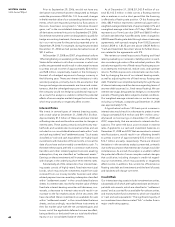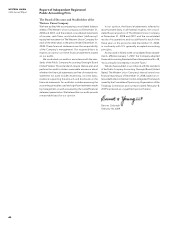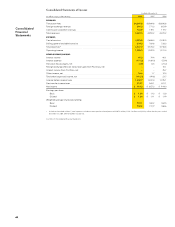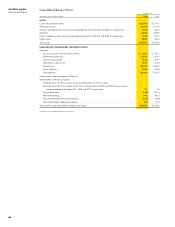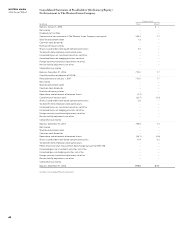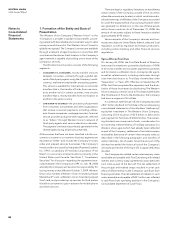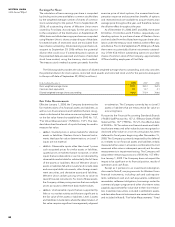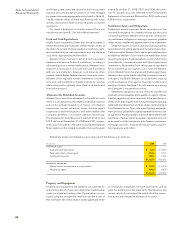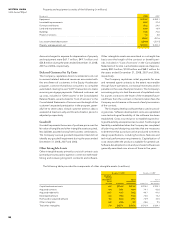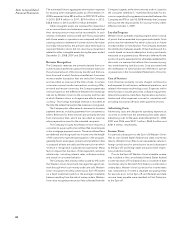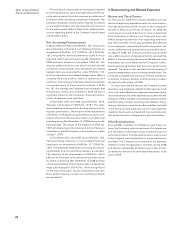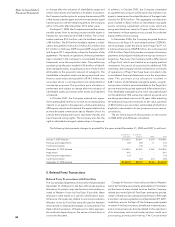Western Union 2008 Annual Report Download - page 52
Download and view the complete annual report
Please find page 52 of the 2008 Western Union annual report below. You can navigate through the pages in the report by either clicking on the pages listed below, or by using the keyword search tool below to find specific information within the annual report.WESTERN UNION
2008 Annual Report
5050
1. Formation of the Entity and Basis of
Presentation
The Western Union Company (“Western Union” or the
“Company”) is a leader in global money transfer, provid-
ing people with fast, reliable and convenient ways to send
money around the world. The Western Union® brand is
globally recognized. The Company’s services are available
through a network of agent locations in more than 200
countries and territories. Each location in the Company’s
agent network is capable of providing one or more of the
Company’s services.
The Western Union business consists of the following
segments:
º
CONSUMER-TO-CONSUMER—money transfer services
between consumers, primarily through a global net-
work of third-party agents using the Company’s multi-
currency, real-time money transfer processing systems.
This service is available for international cross-border
transfers—that is, the transfer of funds from one coun-
try to another—and, in certain countries, intra-country
transfers—that is, money transfers from one location to
another in the same country.
ºCONSUMER-TO-BUSINESS—the processing of payments
from consumers to businesses and other organizations
that receive consumer payments, including utilities,
auto finance companies, mortgage servicers, financial
service providers and government agencies, referred
to as “billers,” through Western Union’s network of
third-party agents and various electronic channels.
The segment’s revenue was primarily generated in the
United States during all periods presented.
All businesses that have not been classified into the con-
sumer-to-consumer or consumer-to-business segments are
reported as “Other” and include the Company’s money
order and prepaid services businesses. The Company’s
money orders are issued by Integrated Payment Systems
Inc. (“IPS”), a subsidiary of First Data Corporation (“First
Data”), to consumers at retail locations primarily in the
United States and Canada. See Note 7, “Investment
Securities” for discussion regarding the agreement exe-
cuted between the Company and IPS on July 18, 2008
whereby the Company will assume the responsibility for
issuing money orders effective October 1, 2009. Western
Union also markets a Western Union branded prepaid
MasterCard® card, a Western Union branded prepaid
Visa® card, and provides top-up services for third parties
that allow consumers to pay in advance for mobile phone
and other services.
There are legal or regulatory limitations on transferring
certain assets of the Company outside of the countries
where these assets are located, or which constitute undis-
tributed earnings of affiliates of the Company accounted
for under the equity method of accounting. However, there
are generally no limitations on the use of these assets
within those countries. As of December 31, 2008, the
amount of net assets subject to these limitations totaled
approximately $193 million.
Various aspects of the Company’s services and busi-
nesses are subject to United States federal, state and local
regulation, as well as regulation by foreign jurisdictions,
including certain banking and other financial services
regulations.
Spin-off from First Data
On January 26, 2006, the First Data Board of Directors
announced its intention to pursue the distribution of 100%
of its money transfer and consumer payments businesses
and its interest in a Western Union money transfer agent,
as well as related assets, including real estate, through
a tax-free distribution to First Data shareholders (the
“Separation” or “Spin-off”). Effective on September 29,
2006, First Data completed the separation and the distri-
bution of these businesses by distributing The Western
Union Company common stock to First Data shareholders
(the “Distribution”). Prior to the Distribution, the Company
had been a segment of First Data.
In connection with the Spin-off, the Company reported
a $4.1 billion dividend to First Data in the accompanying
consolidated statements of stockholders’ (deficiency)/
equity/net investment in The Western Union Company,
consisting of the issuance of $3.4 billion in debt and a
cash payment to First Data of $100.0 million. The remain-
ing dividend was comprised of cash, consideration for
an ownership interest held by a First Data subsidiary in a
Western Union agent which had already been reflected
as part of the Company, settlement of net intercompany
receivables (exclusive of certain intercompany notes as
described in the following paragraph), and transfers of
certain liabilities, net of assets. Since the amount of the
dividend exceeded the historical cost of the Company’s
net assets at the time of the Spin-off, a capital deficiency
resulted.
The Company also settled certain intercompany notes
receivable and payable with First Data along with related
interest and currency swap agreements associated with
such notes as part of the Spin-off. The net settlement of
the principal and related swaps resulted in a net cash
inflow of $724.0 million to the Company’s cash flows from
financing activities. The net settlement of interest on such
notes receivable and payable of $40.7 million was reflected
in cash flows from operating activities in the Company’s
Consolidated Statement of Cash Flows.
Notes to
Consolidated
Financial
Statements


